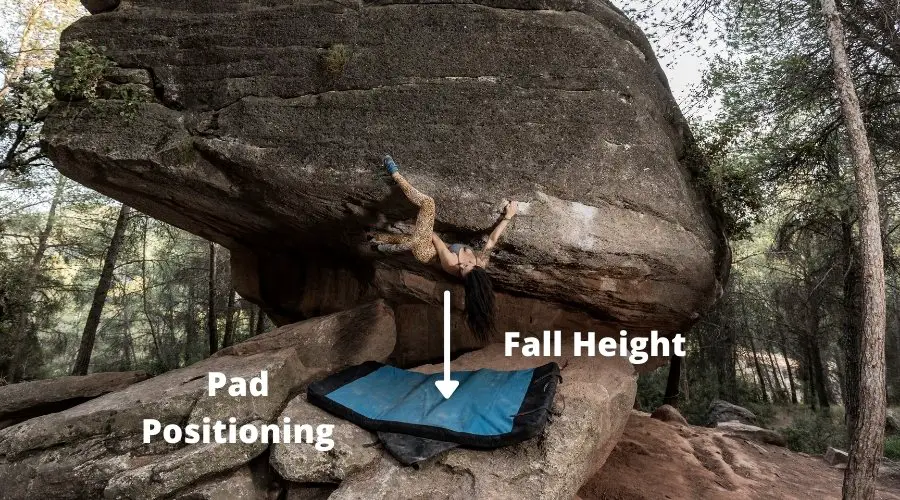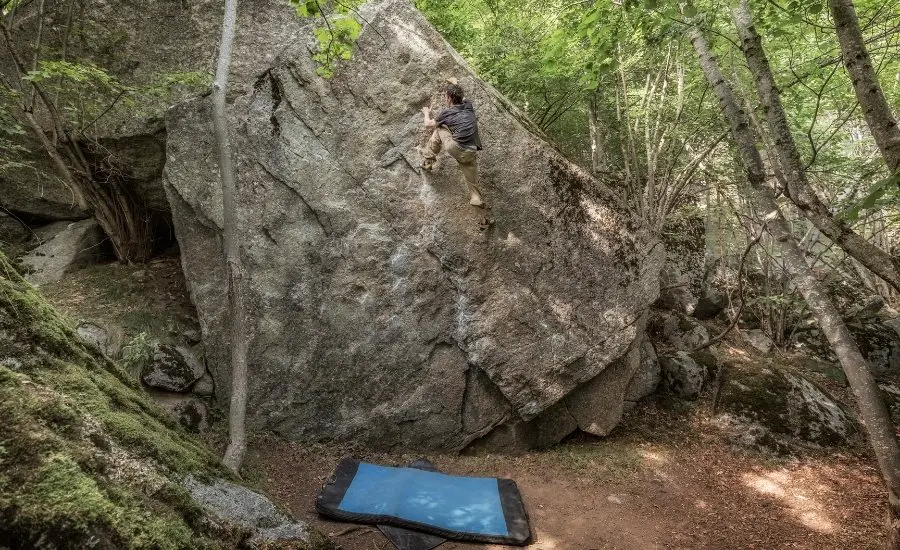Knowing how long a crash pad lasts and when to replace it is key for climbers to stay safe when bouldering. Using an old crash pad that is no longer able to catch you properly is a quick way to get injured. Each crash pad lasts a different amount of time and this depends on many factors.
On average, bouldering crash pads typically last approximately 3 to 5 years with moderate use and proper storage. The pad’s usage, foam type, treatment, positioning and the fall height of the climber all affect how long it will last.
While many factors will affect the lifespan of the crash pad, there are certain ways to help keep it alive and doing well. I have a few climbing buddies who have pads that have lasted them the past decade. Stay tuned to see how exactly a crash pad’s lifespan gets shortened and how to prolong its effectiveness.
If you are interested in seeing what the current prices are for the most popular crash pads, you can find them on Amazon by clicking here. Using the Amazon affiliate link above and/or other links in the article helps support this website.
Expected Lifespan of Crash Pads

Unlike other climbing equipment, crash pads typically will deteriorate over time instead of suffering acute damage (i.e. a rope snapping or harness failing). That said, using them improperly will speed up this process a drastic amount. To see how to properly use a crash pad, check out my article linked here.
Climbing equipment manufacturers will sometimes have warranties or guarantees for their products. Petzl, for example, has a 3 year guarantee on the crash pads they make.
These warranties are good guidelines for the minimum amount of time manufacturers expect their equipment to still be effective. These warranties and guarantees typically take into account poor (but not negligent) use.
This 3 year guarantee agrees well with the widespread sentiment of the climbing community. On average, climbers (using their crash pads a moderate amount) will typically replace a crash pad every 5 years.
That said, there is no set time that a crash pad has to be replaced. Some high quality crash pads that have been minimally used and taken great care of can last climbers over a decade. Lower quality crash pads that have been abused may last climbers less than a year.
It should be retired once it has stopped being effective. A good way to check its effectiveness is to perform a jump test.
To perform a jump test, climb up a couple feet (chair/couch/stairs/etc.) and jump down on it hard. Make sure you jump straight down on it, jumping at an angle can cause the pad to slip out from under you. If it catches you without too much compression then it should be good to go. However, if the pad sinks a lot and you feel like you got close to the ground, it needs to be replaced.
Factors That Affect How Long Crash Pads Last

A lot of different factors will determine how long a crash pad will hold up for. The ones discussed below are the major ones that have a big impact on the lifespan of a pad.
Amount of Crash Pad Use
This is the main factor that will determine how long your pad will be able to last you. Pads can only absorb a limited amount of falls. The more falls your pad takes, the quicker it will lose its effectiveness.
Using the crash pad daily will drastically reduce how long it lasts you compared to using it on a monthly basis.
The Crash Pad’s Foam Type
Pads are made out of two types of foam: open cell and closed cell. Closed cell foam is stronger and more durable than open cell foam. It is responsible for distributing the force of the fall while the open cell is responsible for compressing and softening the landing.
Pads with a larger amount of closed cell foam will typically last longer than pads with a larger amount of open cell foam. This is why pads will compress a lot and not catch you as well when they begin to deteriorate – their open cell foam is starting to wear out.
Care and Storage of the Pad
Improper treatment of your pad will shorten its lifespan.
Dragging it around outside when moving it will scrape it against rocks and other tree routes on the ground. This will eventually cause the pad’s grip to wear out and even form holes in its outer casing. Not patching any holes in the casing will allow water and dirt to get in and affect the pad’s foam.
In addition to this, storing the pad wrong will decrease its lifespan as well. Do not store the pad:
- When it is still wet
- Folded up
- In a hot environment
- In direct sunlight
- When the dirt has not been brushed off
Pad Positioning
Positioning the pad on top of other rocks or irregular objects is a great way to shorten its lifespan and potentially injure yourself.
Crash pads will not be able to distribute the force of a falling climber effectively if they are positioned on an irregular surface. The force of a climber falling on them will be localized on top of the irregularity and damage the pad’s outer casing and inner foam.
Fall Height onto the Crash Pad

Just as pads have a limited amount of falls they can withstand, they have a limited amount of force they can absorb.
Falling from high boulders onto a crash pad will decrease its lifespan. You will help keep yourself safer and extend your crash pad’s lifespan by minimizing your fall height onto the pad. It’s a win-win.
That said, if you plan on doing some high bouldering, certain pads are made for taking higher falls better than others. These “highball” crash pads are bigger and thicker than normal pads and are designed to absorb higher falls. To see my favorite crash pad and highball crash pad, check out my recommended gear page.
Tips to Extend a Crash Pad’s Lifespan
Now that you know how the lifespan of crash pads gets shortened, let’s talk about a few ways to make sure it will last you as long as possible.
Position the Crash Pad on Flat Surfaces
Keeping your pad on flat surfaces will not only help you stay safe when landing on it but will improve the pad’s lifespan. Putting it on top of rocks and roots will preferentially wear down certain parts of the pad quicker than others.
Don’t Drag the Crash Pad When Moving It

Always lift the pad up and carry it whenever possible. Minimizing the amount it is dragged on the ground will help keep the outer casing intact and protect the foam.
That said, sometimes you may have to slide/drag it to keep it under a climber. The climber’s safety should always take precedence over the pad’s care.
Have Multiple Crash Pads
Using multiple crash pads will help reduce the amount of falls any one pad will take during the bouldering session. In addition to this, you will not have to drag or move the pads as much if you spread them out.
If you stack pads on top of each other, you will spread out the falling force onto each of them. This again will prolong their lifespan.
Climbing with multiple pads is always a good idea. Plus any extras can double as a couch!
Patch the Pad with Canvas or Similar Material
If your pad gets a hole in it, you will want to patch this with canvas or a similar heavy duty material. Just normal cloth will not be durable enough to withstand the abuse it will have to take.
By patching it, you will help keep out any water or dirt from getting in and ruining the foam inside the pad.
Store the Pad Properly
Before storing the pad, you will want to make sure it is brushed clean and dry.
When storing it, you will want to keep it opened up and put it in a cool place out of direct sunlight. Allowing it to stay open keeps the pad’s foam in good condition for longer.
